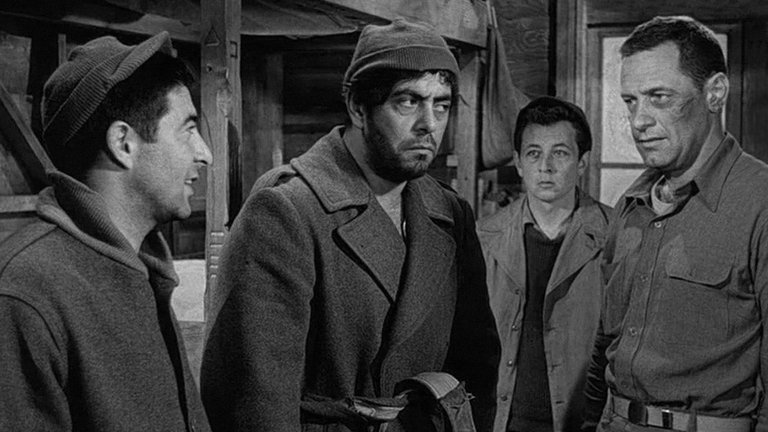Film Review: Stalag 17 (1953)

The most authentic of all Second World War films were those made few years after the end of the hostilities. The memories were fresh, props were available, there was little need of propaganda and, most importantly, they were created by veterans who wanted to show what they really went through. One the best known and the most successful among such works was Stalag 17, 1953 film directed by Billy Wilder.
Two of the veterans behind the film were Donald Bevan and Edmund Trzincski (who appears in small role in the film), US Army Air Force servicemen shot down over Germany and forced to spend last years of the war as prisoners in POW camp. Their experiences inspired them to write a 1949 stage play which became big hit on Broadway and later served as the basis for the film. The plot is set around Christmas 1944 in Stalag 17, large prisoner camp somewhere in today’s Austria, with hundreds of prisoners being downed US airmen. One of those is Sergeant J. J. Sefton (played by William Holden), entrepreneurial cynic whose talent for bribing guards with cigarettes allowed to bring various contraband and organise all kinds of black market and betting schemes that would make life of fellow prisoners in his barracks more interesting. Some of the prisoners, however, decide to escape, but their attempt ends quickly with both men being shot by guards. This incident and Colonel von Scherbach (played by Otto Preminger), prison commandant, apparently knowing many thing that go on, lead prisoners to conclude that they have informer within their own ranks, with Sefton being the most likely suspect.
Billy Wilder has built reputation as one of the most versatile directors in history of Hollywood, and Stalag 17 confirms it within the single film by seamlessly combines elements of different genres - war film, prison drama, thriller, and, most importantly, black comedy. Despite the seemingly unattractive setting of a prison camp, with couple barracks separated by patches of muddy ground, two hours of running time pass quickly and Wilder again shows his talent by easily transcending stage origins of the script. This blending of genres allows Stalag 17 to capture the complexities of wartime experiences while also infusing moments of levity and entertainment. The witty and sharp dialogue, coupled with the poignant and suspenseful scenes, contributes to the film’s overall success.
William Holden won Oscar for Best Actor as Sgt. Sefton, although the actor himself would later allegedly claim that he didn’t deserve it, and it was given as consolation prize for snubbing of Sunset Boulevard three years earlier. It is easy to agree with such estimate, because although Holden plays his part with ease, Stalag 17 is in its essence an ensemble piece, with many dependable character actors playing parts that easily overshadow Holden’s. This includes Peter Strauss in the memorable role of sex-crazed Stanislas “Animal” Kuzawa and Harvey Lembeck as his best friend Harry Shapiro; two actors form great comedy duo that would provide many of the light-hearted moments this otherwise grim film needs. Famous director Otto Preminger also has a lot of fun in his first feature film role playing a character reminiscent of the POW camp commandant played by Erich von Strocheim, another famous director, in Renoir’s The Grand Illusion.
Paramount Pictures, studio behind the film, originally didn’t believe in Stalag 17, with executives thinking that the audience wouldn’t find films about POWs attractive – an issue, which is semi-ironically, addressed by character of Clarence Harvey “Cookie” Coook (played by Gil Stratton) in opening narration. Thankfully, the end of Korean War and return of American POWs coincided with the film’s release, creating enough public interest to make the subject relevant and turn Wilder’s work in big box office hit. It served as inspiration for future films with similar subject, like The Great Escape and, more importantly, popular 1960s TV series Hogan’s Heroes. While some references in the film may be lost on modern audiences unfamiliar with WW2, Stalag 17 has in general aged very well and solidified its place in history of cinema.
RATING: 8/10 (+++)
Blog in Croatian https://draxblog.com
Blog in English https://draxreview.wordpress.com/
InLeo blog https://inleo.io/@drax.leo
Hiveonboard: https://hiveonboard.com?ref=drax
Rising Star game: https://www.risingstargame.com?referrer=drax
1Inch: https://1inch.exchange/#/r/0x83823d8CCB74F828148258BB4457642124b1328e
BTC donations: 1EWxiMiP6iiG9rger3NuUSd6HByaxQWafG
ETH donations: 0xB305F144323b99e6f8b1d66f5D7DE78B498C32A7
Posted using CineTV
